Avoiding the Agency Trap – Product Led Companies Scale-Up
When we were little, we talked about what we wanted to be when we were older. Some of us perhaps wanted to be firefighters, or teachers, or maybe even astronauts.
What about asking ourselves what we want our companies to be when they grow up? Do you want something that pays the bills for you and your business partner and your teammates? Do you want something that gives you purpose and something important to do? Do you want to solve hard world problems, and achieve financial gain, maybe IPO and make your millions?
There’s a lot of different ways to run a respectable and profitable business, but there are limited ways to scale a business. And unless you’re setting your goals and expectations early, it’s easy to go off track and build a company that doesn’t grow up into what you imagined.

Do you ever feel like you’re getting pulled in two directions?
As a product person, I’ve often felt like I’ve had the pressure to deliver like a project manager. It’s a little like having an angel and a devil on each shoulder.
One is telling you to dive in and ask why, and to understand the problem deeper, and to maybe group together these two parts that solve similar problems into one… while the other is yelling at you to stick to the plan, to avoid scope creep, to just deliver on time and get the job done!

As a product person, you should cherish every moment you get to spend in discovery mode. This is where the big, juicy problems of the world are found and cracked, and real value is discovered.
Delivery is when you’re honing in on that one problem, and is really more of a means to an end. You have to have delivery, as it ultimately pays the bills, but it’s not the earth-moving disruptive activity that discovery has the potential to be.
You have to have balance – you have to find enough time to discover problems, and of course, spend some time delivering on those solutions.
But what if this gets thrown off balance? What if you’re like me, and you end up starting out with great intentions to discover problems and interesting ways to solve them, but before you know it, you’ve got your hands tied with too many delivery commitments?
About 12 years ago, I was a product person for a company in London. I was meant to join the team as a product manager, but after a week or so there, it became clear that I was really lined up to do a lot more project management than I’d anticipated.
The company hadn’t knowingly mis-sold me on the job. They’d just gotten stuck in a trap that I now know is really common, as I see it all the time amongst other product teams that I spend time with.
I’m here to warn you about it and hopefully help keep you from the same trap. I’ve delivered this advice as a keynote talk at a number of product conferences and events. If you want to take the learning away, feel free to help yourself to the accompanying slides👇 They should help illustrate everything I cover in this piece and can help you talk through the ideas with your teams.
Download the slides
The Power of Product Discovery
Why is discovery so powerful?
Discovery is at the heart of what product teams do. The very nature is to cast a wide research net to identify problems and hold back from committing to a solution. The product team then has a process of, essentially, guessing and checking to optimize to find the best solution that’s cost-effective, desirable to the market, feasible to build, and valuable for the business.
It’s a process that can take years, and is messy, and doesn’t guarantee success by any stretch. But when it is successful, it pays off in spades.
Contrast this with how agencies work. In an agency, a client identifies a problem for you and enlists your team to tackle the problem, and then you and your team get paid for that piece of work.

The biggest indicator of your ability to scale is to look at what it is that you actually sell, as a business.
This determines whether you’re more of a product company or an agency.
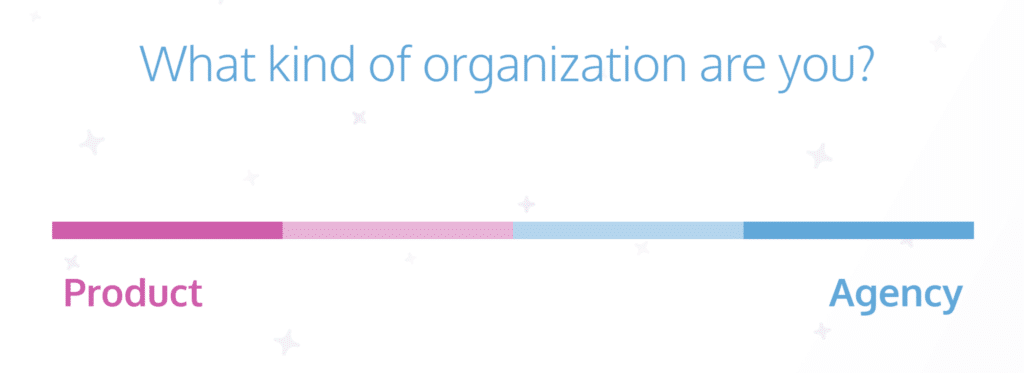
Agencies sell their time in exchange for money. This usually takes the form of client contracts and projects.
Product companies, on the other hand, sell value that they create.
Time is the one thing we can’t create more of, it’s the ultimate limited resource, and so agency-style businesses can only scale with more human resources – more people providing more of their time to the business.
Product companies are able to create value, by investing time upfront, into a mix of products or services that can be resold again and again, without needing a directly proportionate number of humans involved to scale.
This is why product companies can go from start-up to scale-up and grow into such enormous tech giants, and fundamentally, why agencies can’t.
Now, there’s absolutely no shame in building and running an agency. It’s a brilliant way to make money and create purpose, solve problems, and get paid. But if you want to become a unicorn it isn’t the business model you need.
Product companies change the world!
But agencies don’t change the world. Product companies do!
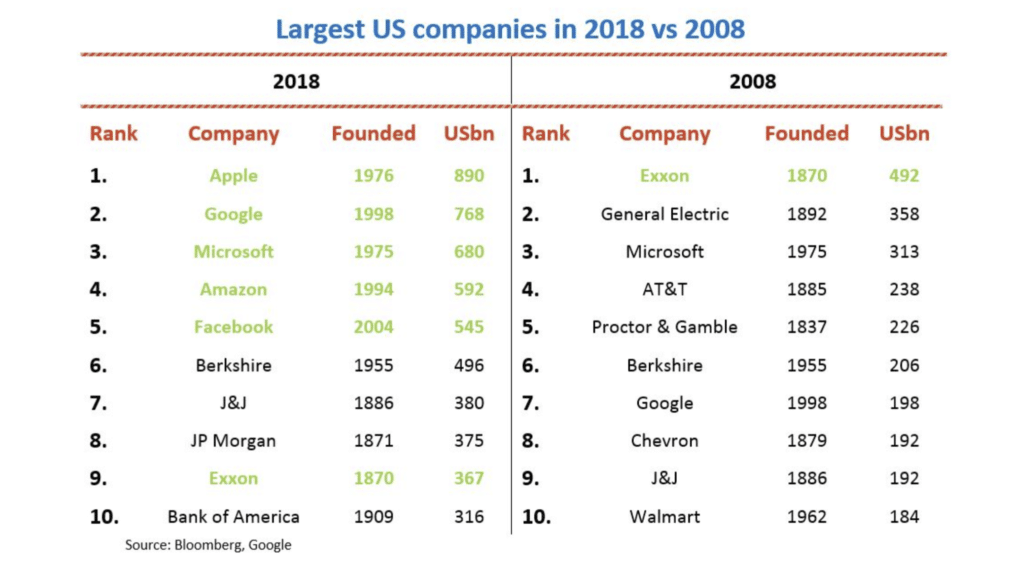
If you take a look at the companies storming the charts in the last decade, it’s tech companies who invest in scaling the product side of their business.

Here’s a look at the S&P index, and how Netflix, Amazon, and Google are outperforming even the best of the best, with their product-minded approach.
And so, so many companies go in with this idea of building and scaling a product company, but end up in this same trap that I did in this previous job.
Acting like an agency.
Taking on client jobs and commitments, and carving into their time that would otherwise be spent on discovery.
And rather than take off, it can cause companies to sputter and fail.
What’s going on here?
How agencies work
Imagine you’ve got a business, and it’s got a monthly cost – let’s say this is you and 3 team members. And that’s you in month 1.

Assuming all things equal, this is you over the following months too. Low-cost team, but still a cost.

Now, you can’t go on spending forever, you need money. If you’re setting yourself up to be an agency, then you can take on work and start selling your time.

If you’re any good at business, you’re selling your work at more than it costs you.
Your cumulative sales go up, and your monthly profit is tidy but small.

Okay, so you want to grow your profits? You can grow your team! Then you’ll have more time to charge out for client projects. Your profit goes up a bit. Your growth is still a stick straight line, however. There’s no exponential growth in sight.
If you wanted to be rolling in it, in this agency model, you’d have to hire and manage a lot of people.
How product companies work
A product company, on the other hand, has an entirely different way of working.
They usually start off with a group of founders, and maybe some ideas and connections, but not a lot else. They’ve got a monthly cost, but aren’t selling their time in agency work. They’re investing it in a product that hopefully will sell in the future.

The cumulative sales is huge though. Once you’ve got something of value that sells, the sky is the limit.
Yes, you’ll sometimes need to bring the size of your team up to support the growth, but nothing like the 1 for 1 nature you get with trying to scale an agency when you’re selling project hours worked.
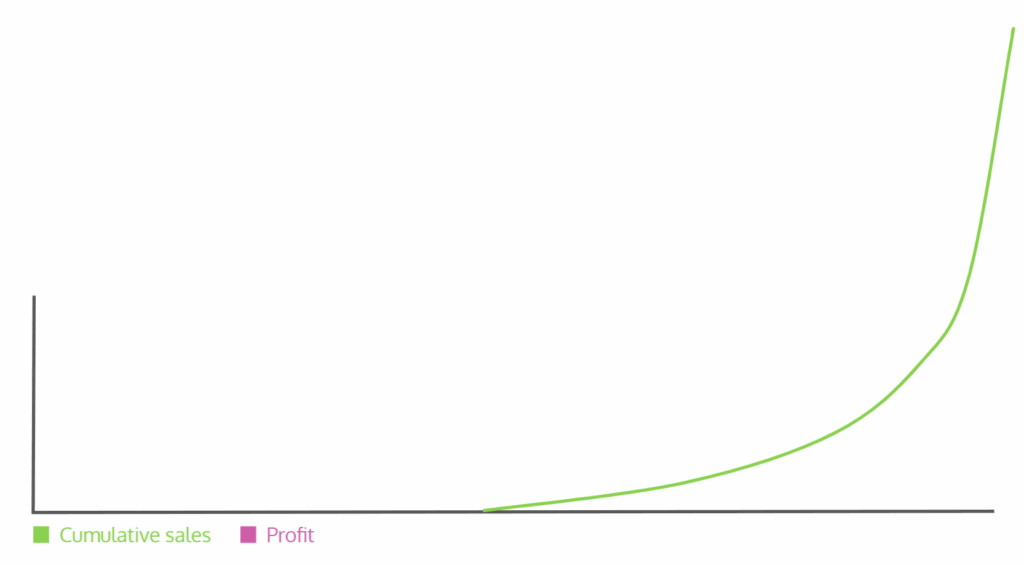
You might notice that I didn’t include the profit on this diagram. That’s because it’s probably still way below zero.
This is the fundamental problem with product companies and what makes them tricky. In order to get to the point of having something that sells in a scalable way like this, it can take months or years. That’s months or years without getting paid. How does that work?
Well, this is why startup funding is so popular.

It buys your team time to figure out what the product that creates value will be, so you can survive the months until you actually generate money of your own.
Or, if you’re so lucky, maybe you have money of your own to invest in, or can live and work without a salary for a while, or have access to government grants.
Okay, now this might seem really oversimplified, and it is, for anyone who knows their way around how startups work. But it’s important to keep in mind because I’ve seen even the savviest companies fall prey to this one trap.
See, there’s a danger zone.

It’s so much easier and faster to make instant money in an agency-style business.
If anything ever goes wrong in the plan, or heck, sometimes all it takes is a little bit of temptation, it’s easy to fall into this habit:
A client who comes to you asking for something a little bit custom. An offer of what would otherwise be a month or more of payroll in one fell swoop, and all it takes is you to stand there and say or do things that you already basically do for free for the company otherwise.
What’s the harm in taking on one little project if it lines your pockets or keeps the lights on?
Because what happens, is you go from envisioning this scenario, where you’re able to discover a problem, solve it well, and make lots of money before anyone turns up asking for rent…
To this scenario:

Your initial investment ends up running short, your costs are that much higher, and it takes longer than you might imagine getting to product/market fit. All of a sudden, you’re a dollar short and a day late.
Nearly every start-up starts off with great intentions of following a scientific methodology of measuring, learning, and iterating until they’ve solved the most valuable problems in the world.
But these go out the window in times of stress.
Sometimes, “whatever we need to do to get to the next round” actually becomes selling time for money.

Agency work, done by a team who has otherwise configured themselves as a product team. It solves the immediate problem at hand, which is preventing the lights from going out…

…but it also usually means that the product work gets delayed and delayed.
Because let’s admit it. Making money and cashing cheques is addictive.
After all, ideas are nothing, it’s all about the execution right? That’s the power of delivery.
Except that every minute of time a client buys to have you work on their problems is a minute you can’t spend discovering and solving the bigger problems in the world.
There’s a chance that the client happens to identify a problem that’s big enough to apply to a wider market and you’re able to solve it at the same time as solving for the paying client, but those chances are slim. More often than not, you’re really just in delivery mode, and you haven’t just magically leapfrogged months or years of discovery.
Signs you’re veering into Agency Mode
So, as someone who’s been there, and has seen countless companies end up down this path, I can share some signs that your company is veering into agency mode.
1. Sales Led Roadmap
The roadmap is such a telling feature of any company.
In a discovery-led company, the roadmap should be a series of problems to solve and should facilitate the discussion of what could be solved and in what order, to fulfill the product vision.
In a sales-led organization, the roadmap looks more like this:
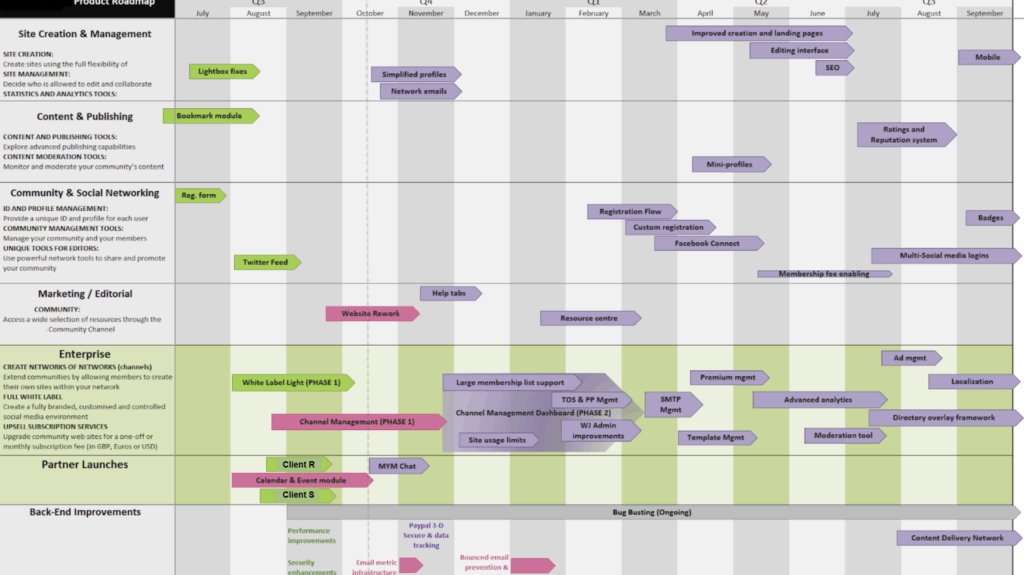
This is actually my roadmap, from years ago.
The grey areas represented discovery-led work, where we were building for the wider market and trying to find the biggest, juiciest problems in the space to solve, and the best ways to solve them.
Unfortunately, our time was dominated by the work in the green strip, what we called ‘Enterprise’ and ‘Partner launches’. These were things that we were doing to close specific deals by specific dates.
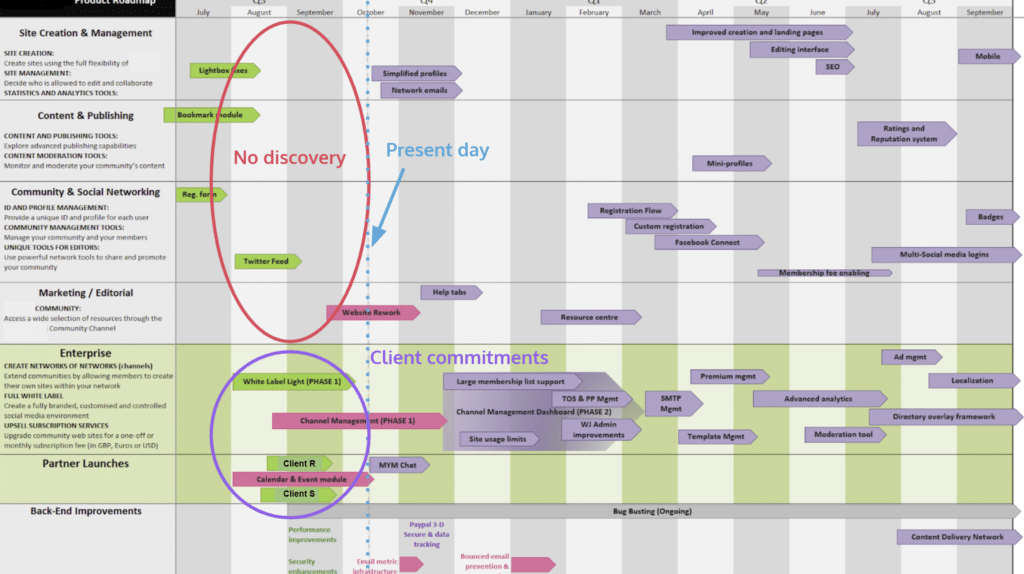
Sure, it got us paid that month, but look at what the cost was. For the preceding quarter, in particular, the month and a half before this roadmap was generated, we basically did nothing to further the vision of our core product. All of our work was tied up in partner work.
And while it looked like the partner work cleared up in the future, it never did. Our salespeople were always coming back with a big grin on their face to tell us about the next thing that they’d sold, only for us to find out it required work on the roadmap to make it fit. Ultimately, we didn’t do a fraction of the discovery work this roadmap suggests we were going to do in the future. Ultimately, this business failed.
A discovery-led roadmap looks entirely different.
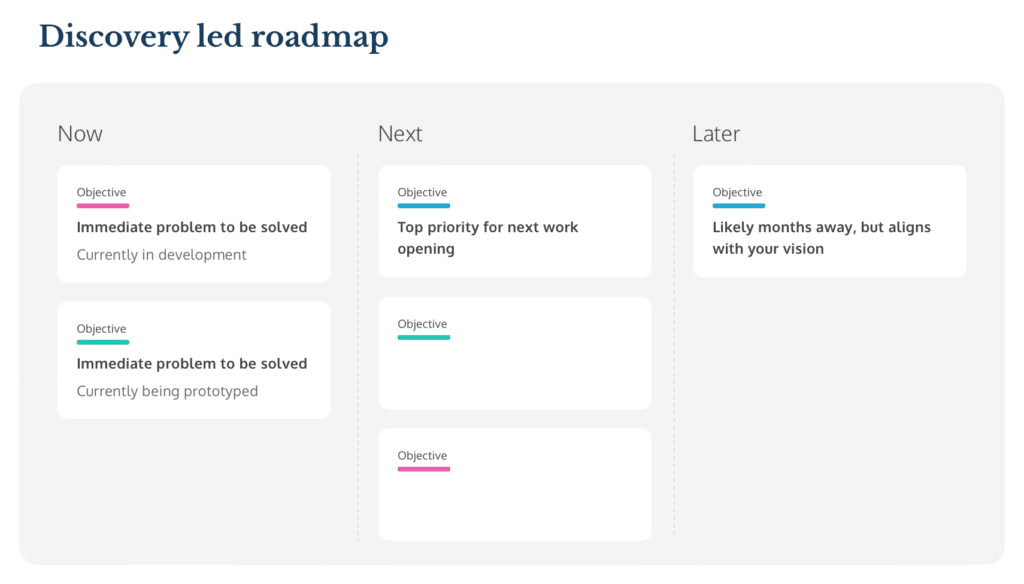
It’s centered around business objectives to meet, like revenue or user targets, and customer problems to solve, and the product manager uses the roadmap to make sure that things are prioritized to make the most use of resources, and are spending time discovering in the most interesting and valuable problem areas first.
It’s not overrun by client commitments.
2. A Product Manager who’s actually just a Project Manager
Another sure sign that you’re veering into agency mode is when your product manager is having to act the part of the project manager.
A project manager’s job is to gather requirements, figure out the scope of the project, and then guide the project through to completion, managing resources, milestones, delivery processes, and other constraints along the way.
I’ve been in this position, where I was hired as a product manager, but found myself sat in front of clients essentially taking down a list of requirements and helping to write up quotes for custom work.
I’ve spent far too much of my time breathing down the necks of development teams, trying to get estimations, and creating “accurate” buffers to report back to the sales team and clients.
This was all time that I couldn’t spend figuring out if there were bigger problems to solve, and how we might be the ones to solve them.
3. Feature Factory
Another sign you’re veering into delivery mode and out of discovery is that you’ve become a feature factory.
This one is so easy to fall into, as it starts when the company is young.
In the early days, each new feature gets you more downloads, more press, more sales. It improves your product, measurably.
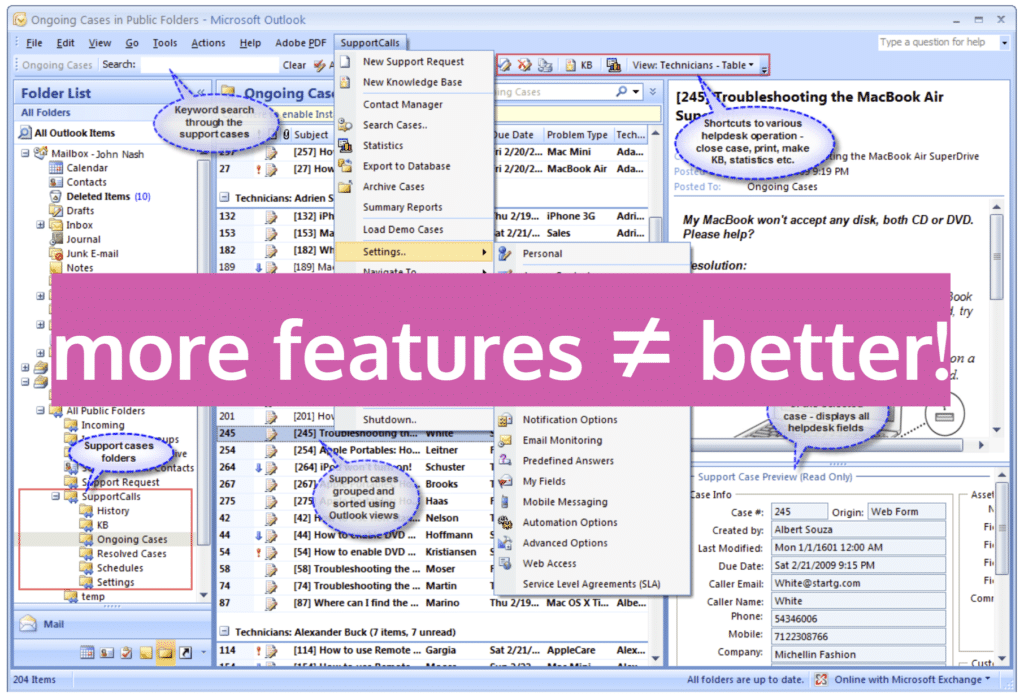
But over time, each new feature begins to weigh you down. It doesn’t give you the same boost, and you end up with a Frankenstein of a product.
We’re addicted to our features. We can’t quit the habit of building features because of the pressures from those around us.
- Like the salesperson saying they can’t sell the product without that one last feature
- Or your marketing bod pointing out that you’re lacking a feature that would mean some vital checkmark on their pricing grid
- Or that inner voice that tells you that you just need this one thing to tip your numbers into a viral growth loop
- Or the eternal question from your board, your boss, your customers, from everyone: When is this coming out?
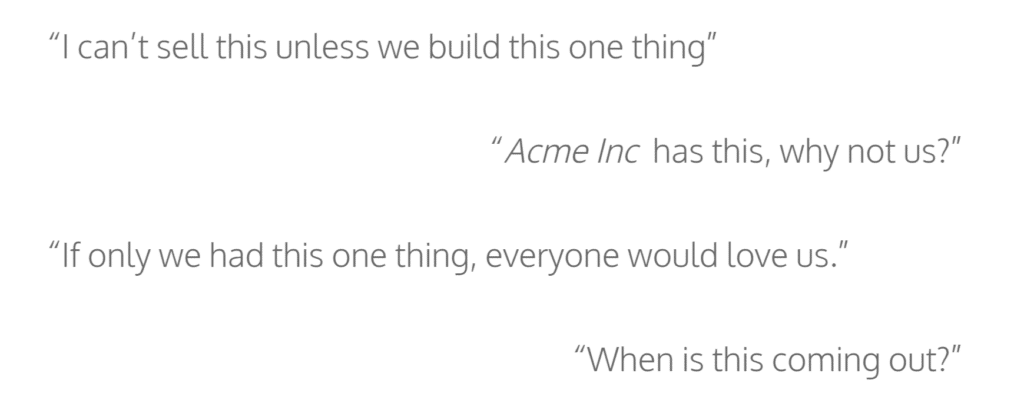
Teams stuck in a feature factory are constantly chasing the next idea and spending a lot of effort on getting work out the door, but not a lot of effort on making sure that they are doing the right work in the first place.
Some typical patterns to watch for include:
- Having very specific ways of prioritizing the ‘right’ idea, but those methods tend to be very sensitive to changes in the market or even opinion
- Lots of emphasis on moving quickly and getting work out the door. Watch for terms like ‘agile cadence’, ‘burn down’, ‘velocity’. These are delivery metrics that measure your ability to ship fast, but not the ability to ship well or to discover the right things
- Very little time granted to validating that past launches were successful and impactful and that the right things were actually shipped. A common habit is to launch ‘experiments’ but not actually check the results
A better approach is to take a step back and prioritize at the problem level, not at the idea level.
This tends to avoid the trouble of getting stuck in a very granular priority system (like stack ranking or weighted scoring for ideas), and instead allows your team to focus on the company-level objectives and figuring out the order in which to tackle the problems and opportunities ahead.
It helps to prevent your team from being distracted by that ‘one feature’ that will woo a client, and instead focus on the big picture.
How to get out of the Agency Trap!
So how do you go about getting out of this pattern?
Acknowledge it and have tough conversations
If you recognize that you’ve been doing this, bring it up with your team, and make sure that it’s acknowledged at the exec level. It’s often a tough conversation, as it means admitting that sacrifices have been made, but it’s important that everyone in key roles in the business knows what’s happening and how it impacts the outlook of the company.
Set your ideal outcome: What kind of company do you want to be?
As part of that conversation, ask and answer the question: What kind of company do you want to be?
Perhaps taking on lots of client work is all part of the plan, as the company actually does want to operate more as an agency in the future. That’s okay! It’s better that you all know that now, and can adjust your roles and expectations accordingly.
Perhaps the aspiration is to be a huge tech company, and these short-term delivery commitments are just a means to an end. That’s okay too. We’ve all been there. It’s totally okay to take on some work like that, if it means not having to go for a risky round of funding, or if it enables you to grow the team to get to the next stage.
It’s just really important that you have these tough conversations and align everyone in the team with what the ultimate goal is so that the best strategic decisions are made, and everyone heads in the same direction.
Rearrange and train the team where needed
This is the toughest step.
You might have a salesforce who’s out there selling future versions of your product that you’ve decided you no longer want to commit your team to delivering.
You might need to repurpose this team or rightsize this division to match your now clarified company aspirations.
You might have team members who are ingrained in the delivery mindset, who aren’t used to or prepared for a discovery-led process. You’ll have to work at the exec level to make sure there’s adequate support and training so the team doesn’t flounder when given a little bit of free rein for discovery.
Separate agency work and charge accordingly
Separate your agency work into a different business unit along with its own space for custom work.
Charge separately for this, and charge well! Remember that time is the most limited resource you have. If someone’s asking for custom development, do not be afraid to ask for eye-watering fees for the honor.
Remember, they are buying time that you could otherwise be using to be building your rocket ship. Their alternative might be any other development team out there… but is it really?
They are probably coming to you for custom development because you built something special and proprietary in the first place. You might be the only team in the world actually able to give them specifically what they want. Their alternative, if they don’t buy the product as is, or don’t pay your handsome fee for custom work, is to spend years rebuilding your product and then doing the custom bit on top themselves, or finding some other team to do this for them.
Sure, they might go with a competitor, but there’s a reason they are asking you. And sure, you might lose some deals this way.
But remember, you’re a product company. You’re selling a product that you’ve created. You’re not an agency at heart, selling your time.
Otherwise it’s not worth your time! Charge way more for the clients you keep and get rid of the time-wasters.
Decrease dependence on project delivery cash
And finally, decrease your dependence on the cash that comes in from committed client or contract work, by being deliberate with how much time you spend in delivery and discovery.
If today, it’s 80% delivery and 20% discovery that takes up your team’s time, can you get that to a 70/30 split by next month? When can you get that to a 50/50 split?
Plan out steps in your strategy that look at how you’ll build up your core product so it’ll sell more and more, so that you’re less dependent on external funding from clients and custom work, and more free to solve problems in the core product itself.
It won’t happen overnight, but nor will it happen by itself. It will take you and your team to gather around, admit there’s a dependency on agency mode work, and a concerted effort to make a plan to get away from it.
Final note
But remember, you don’t have to go product!
There’s a big world out there and lots of ways of providing value. If you’re going to go the agency route, then acknowledge it, own it, hire for it, and do it properly, including setting pricing and expectations accordingly.
Don’t fall prey to the most common killer of product companies. Product companies get sucked in by the allure of agency work because it solves an immediate problem in the near term but forces them to take the eye off the ball.
If done well, it can bridge them elegantly to their next stages and on to success.
But if done badly, it can doom your company.
Start acting now, to identify and work towards building the type of company you want in the future.
Just remember to ask yourself, what kind of company do you want to grow up to be?
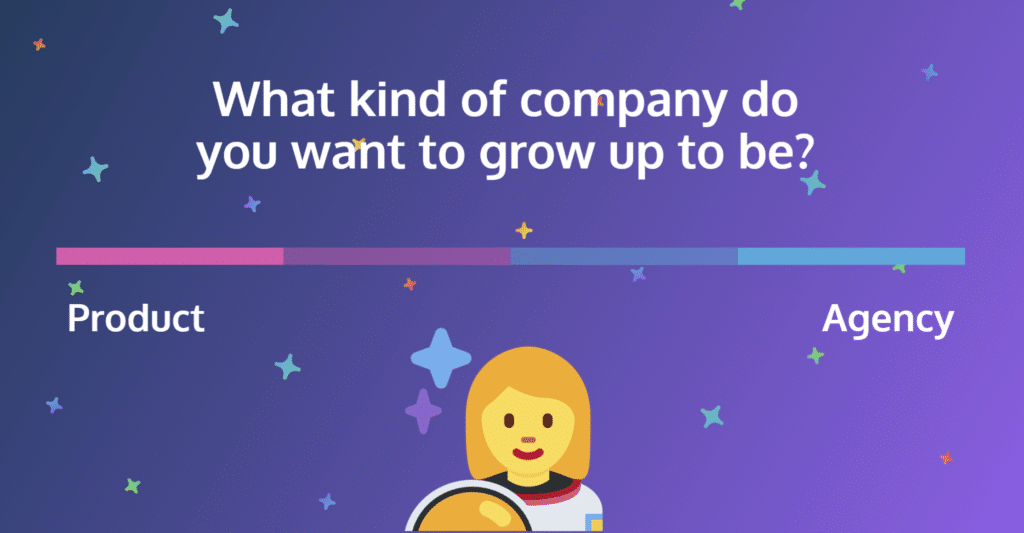
Read more:
8 thoughts on "Avoiding the Agency Trap – Product Led Companies Scale-Up"
Comments are closed.


Wow, what an insightful and well written article. I’ve forwarded to all our Product Managers though it is probably the higher up leadership that needs to discuss it as a group and make the decision you laid out so well. Bravo!
Thank you Vic! It’s great to know our article is helpful!
I can only echo what Vic has written and say that this has to be one of the most insightful articles I’ve read on this subject so far. I’m currently reading Melissa Perri’s book ‘Escaping the Build Trap’ and this article summarises so much of what she talks about, but in a way that is easily digestible and can therefore be shared with colleagues and senior leaders to read. Thanks all, this is one of my favourites of yours to date.
That’s wonderful to hear, thanks for the feedback and for sharing this article around, Sam! 🌟
Extremely well thought out article that really resonates. The bullets around ‘typical patterns’ feels familiar!
Thank you so much for this feedback. It’s lovely to know our articles are well received.
Brilliant analysis and synopsis of concepts so difficult to communicate under pressure from sales to close deals. Transforming a sales-led org into product-led requires iterating on these principles until they take hold. Thank you, thank you!
Ace, thanks for the feedback Bruce, I’m glad this analysis was of value 😁